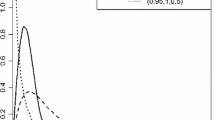Abstract
In this paper, we propose a novel and mathematically tractable frailty model for clustered survival data by assuming a generalized exponential (GE) distribution for the latent frailty effect. Both parametric and semiparametric versions of the GE frailty model are studied with main focus for the semiparametric case, where an EM-algorithm is proposed. Our EM-based estimation for the GE frailty model is simpler, faster and immune to a flat likelihood issue affecting, for example, the semiparametric gamma model, as illustrated in this paper through simulated and real data. We also show that the GE model is at least competitive with respect to the gamma frailty model under misspecification. A broad analysis is developed, with simulation results explored via Monte Carlo replications, to evaluate and compare models. A real application using a clustered kidney catheter data is considered to demonstrate the potential for practice of the GE frailty model.







Similar content being viewed by others
References
Aalen, O. O. (1992). Modelling heterogeneity in survival analysis by the compound Poisson distribution. Annals of Applied Probability, 4, 951–972.
Andersen, P. K., Klein, J. P., Knudsen, K., Palacios, R. T. (1997). Estimation of variance in Cox’s regression model with shared gamma frailties. Biometrics, 53, 1475–1484.
Balakrishnan, N., Peng, Y. (2006). Generalized gamma frailty model. Statistics in Medicine, 25, 2797–2816.
Brostrom, G. (2016). eha: Event history analysis. R package version 2.4-4. https://CRAN.R-project.org/package=eha. Accessed March 2018.
Callegaro, A., Iacobelli, S. (2012). The Cox shared frailty model with log-skew-normal frailties. Statistical Modelling, 12, 399–418.
Christian, N. J., Ha, I. D., Jeong, J. H. (2016). Hierarchical likelihood inference on clustered competing risks data. Statistics in Medicine, 35, 251–267.
Cox, D. R. (1972). Regression models and life-tables (with discussion). Journal of the Royal Statistical Society B, 34, 187–220.
Crowder, M. (1989). A multivariate distribution with Weibull connections. Journal of the Royal Statistical Society B, 51, 93–107.
Duchateau, L., Janssen, P. (2008). The frailty model. Springer series in statistics. New York: Springer.
Enki, D. G., Noufaily, A., Farrington, C. P. (2014). A time-varying shared frailty model with application to infectious diseases. The Annals of Applied Statistics, 8, 430–447.
Fletcher, R. (2000). Practical methods of optimization (2nd ed.). New York: Wiley.
Giner, G., Smyth, G. K. (2016). statmod: Probability calculations for the inverse Gaussian distribution. R Journal, 8(1), 339–351.
Gupta, R. C., Gupta, P. L., Gupta, R. D. (1998). Modeling failure time data by Lehman alternatives. Communications in Statistics: Theory and Methods, 27, 887–904.
Gupta, R. D., Kundu, D. (1999). Generalized exponential distributions. Australian and New Zealand Journal of Statistics, 41, 173–188.
Gupta, R. D., Kundu, D. (2001). Exponentiated exponential family: An alternative to gamma and Weibull distributions. Biometrical Journal, 43, 117–130.
Ha, I. D., Pan, J., Oh, S., Lee, Y. (2014). Variable selection in general frailty models using penalized h-likelihood. Journal of Computational and Graphical Statistics, 23, 1044–1060.
Hougaard, P. (1984). Life table methods for heterogeneous populations: Distributions describing the heterogeneity. Biometrika, 71, 75–83.
Hougaard, P. (1986). A class of multivariate failure time distributions. Biometrika, 73, 671–678.
Hougaard, P. (2000). Analysis of multivariate survival data. New York: Springer. Springer series. in Statistics.
Hougaard, P., Harvald, B., Holm, N. V. (1992). Measuring the similarities between the lifetimes of adult danish twins born 1881–1930. Journal of the American Statistical Association, 87, 17–24.
Ibrahim, J. G., Chen, M. H., Sinha, D. (2001). Bayesian survival analysis. Springer series in statistics. New York: Springer.
Klein, J. P. (1992). Semiparametric estimation of random effects using the Cox model based on the EM algorithm. Biometrics, 48, 795–806.
Knaus, J. (2015). Snowfall: Easier cluster computing (based on snow). R package version 1.84-6.1. https://CRAN.R-project.org/package=snowfall. Accessed Mar 2018.
McGilchrist, C. A. (1993). REML estimation for survival models with frailty. Biometrics, 49, 221–225.
McGilchrist, C. A., Aisbett, C. W. (1991). Regression with frailty in survival analysis. Biometrics, 49, 461–466.
Munda, M., Rotolo, F., Legrand, C. (2012). Parfm: Parametric frailty models in R. Journal of Statistical Software, 51(11), 1–20.
Nadarajah, S., Kotz, S. (2006). The beta exponential distribution. Reliability Engineering and System Safety, 91, 689–697.
Nielsen, G. G., Gill, R. D., Andersen, P. K., Sorensen, T. I. A. (1992). A counting process approach to maximum likelihood estimation in frailty models. Scandinavian Journal of Statistics, 19, 25–44.
Parner, E. (1998). Asymptotic theory for the correlated gamma-frailty model. Annals of Statistics, 26, 181–214.
R Core Team (2016). R: A language and environment for statistical computing. R Foundation for Statistical Computing, Vienna, Austria. https://www.R-project.org/. Accessed Mar 2018.
Therneau, T. (2015). A package for survival analysis in S. R package version 2.38. https://CRAN.R-project.org/package=survival. Accessed Mar 2018.
Therneau, T. M., Grambsch, P. M. (2000). Modeling survival data: Extending the Cox model. New York: Springer.
Therneau, T. M., Grambsch, P. M., Fleming, T. R. (1990). Martingale-based residuals for survival models. Biometrika, 77(1), 147–160.
Therneau, T. M., Grambsch, P. M., Pankratz, V. S. (2003). Penalized survival models. Journal of Computational and Graphical Statistics, 12(1), 156–175.
Vaupel, J., Manton, K., Stallard, E. (1979). The impact of heterogeneity in individual frailty on the dynamics of mortality. Demography, 16, 439–454.
Wienke, A. (2011). Frailty models in survival analysis. CRC biostatistics series. New York: Chapman and Hall.
Yavuz, A. C., Lambert, P. (2016). Semi-parametric frailty model for clustered interval-censored data. Statistical Modelling, 16, 360–391.
Yu, B. (2006). Estimation of shared gamma frailty models by a modified EM algorithm. Computational Statistics and Data Analysis, 50, 463–474.
Zeng, D., Lin, D. Y., Lin, X. (2008). Semiparametric transformation models with random effects for clustered failure time data. Statistica Sinica, 18, 355–377.
Acknowledgements
The authors would like to thank the Associate Editor and two anonymous referees for their constructive comments and suggestions. The authors also acknowledge the financial support from Fundação de Amparo à Pesquisa de Minas Gerais (FAPEMIG/Brazil) and Conselho Nacional de Desenvolvimento Científico e Tecnológico (CNPq/Brazil).
Author information
Authors and Affiliations
Corresponding author
About this article
Cite this article
Barreto-Souza, W., Mayrink, V.D. Semiparametric generalized exponential frailty model for clustered survival data. Ann Inst Stat Math 71, 679–701 (2019). https://doi.org/10.1007/s10463-018-0658-9
Received:
Revised:
Published:
Issue Date:
DOI: https://doi.org/10.1007/s10463-018-0658-9




